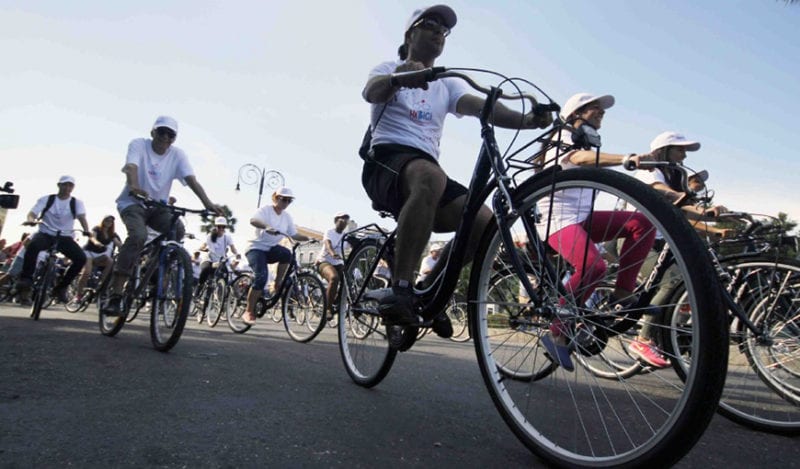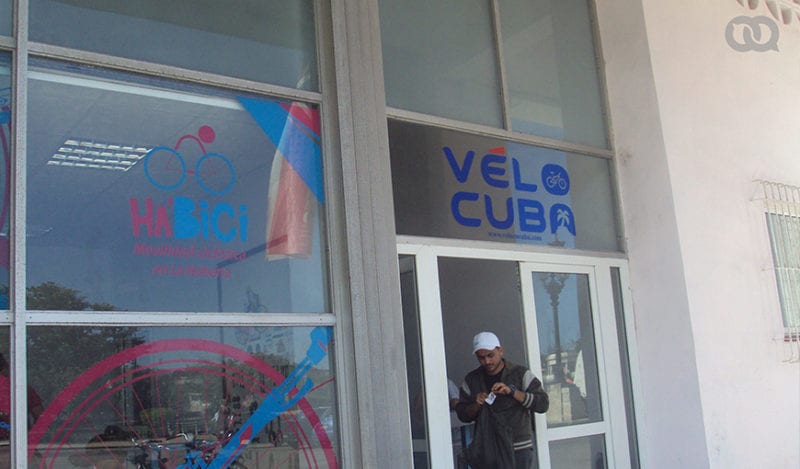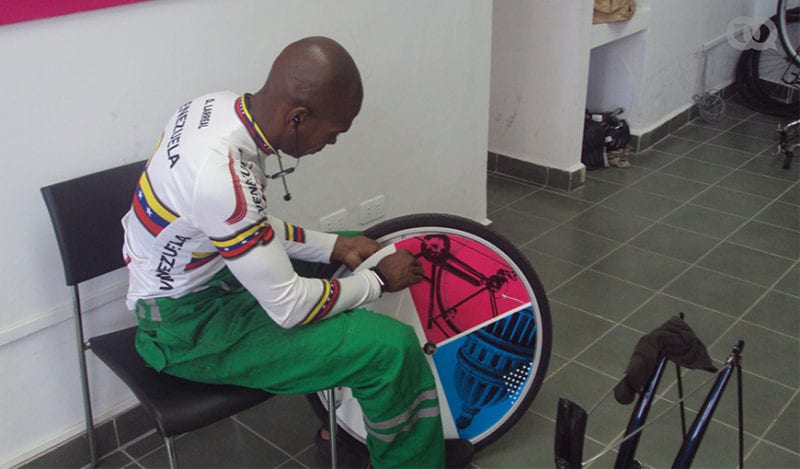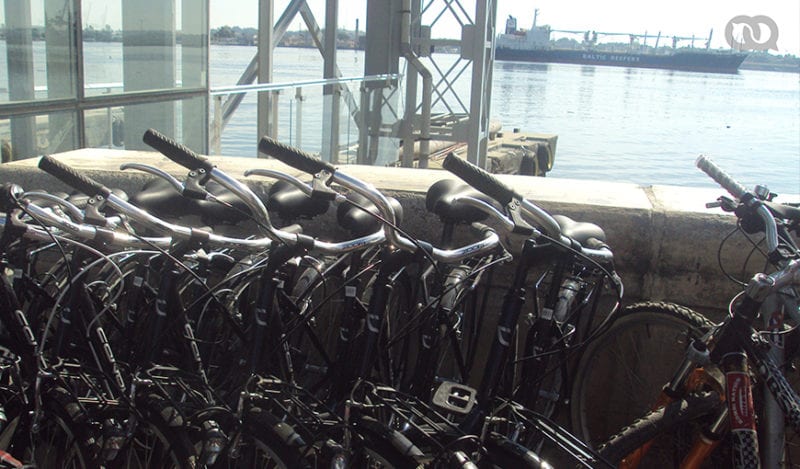Havana Has a New Public Bicycle System & Bike Lanes
Ha’BiCi: a public-private partnership for transportation

By Jeiddy Martinez Armas (El Toque)
HAVANA TIMES – Ha’BiCi, the first public bicycle system in Havana and a pilot project of cycling lanes in the country, came to fruition after just over a year of collaborative efforts between specialists at different departments at the Havana City Historian’s Office, members of the private business “Velo Cuba”; as well as representatives of the Basque Government and its Tecnalia company, who supplied the 60 bikes that are currently in use.
Nayvis Diaz Labaout, who has been overseeing the implementation and running of Ha’BiCi on Velo Cuba’s behalf, remembers that their technical opinions about how this transport system should work and which bikes were best suited for the initiative, were taken into account at different meetings in the lead up to the project’s inauguration in November 2018.
“We didn’t manage to do everything we wanted because the bikes were donated, and we had to work with this. Generally-speaking, we are quite happy to have been chosen and I believe that it wasn’t by chance, that the team had earned it in some way or another, with all of its arduous work to increase bike transport and community projects,” Diaz Labaout says.
Synergy on wheels
Velo Cuba is a group of self-employed who began their bike-repairs project four years ago. Even though they now have over 800 customers, they still remember when they opened up their first workshop behind Coppelia in Havana’s Vedado neighborhood.
In 2016, workers at this business (mostly women) managed to open up their second workshop in Old Havana, on Obrapia Street, between Habana and Compostela Streets. As well as repairing bikes, they began raising awareness and giving road education classes to children and young people in the municipality.
Community activities, a focus on women’s empowerment and a 100,000 CUP (US $4,000) contribution for the development of surrounding areas have received coverage in the national press, the municipal government and Havana’s City Historian’s Office.
The creation of this pilot project was the result of Velo Cuba’s members interest in educating their customers and locals about how to ride on the road, as well as the City Historian’s Office’s willingness to embark on a joint venture with a private business and get a public bike system up and running in Old Havana, which they have wanted to do for years, allowing for a pilot project.
“This kind of project is always undertaken in collaboration with a non-governmental organization, the world over. I don’t know any public cycling project in any city which I have studied, where it is a private endeavor 100% or run by a private owner or all the resources have come from an entrepreneur, because these are all government projects, of social interest and, in fact, prices always need to be cheap because the government allocates a budget for managing the service,” Nayvis Diaz, founder and also the manager of Velo Cuba, explains.
In this case, the government is facilitating all of the infrastructure, via the City Historian’s Office, and Velo Cuba is taking care of the project’s feasibility, economic sustainability and logistics.

Ha’BiCi gave them the opportunity to have a “beautiful branch on Prado 20”, where they handle the upkeep the public bikes. The workshop is located almost in front of the luxury Hotel Packard.
Customers can go to both the head office on Prado (provided by the City Historian’s Office), as well as Ha’BiCi’s sub-headquarters, on Compostela Street, to register, pick up and leave bikes.
In regard to this public-private partnership, Nayvis says that other governments from different countries are interested in donating contributions to this Havana-born initiative so that it can carry on working.
The name “Ha’BiCi” comes from the synthesis of the words “Habana” and “Bicicleta”; its pronunciation invokes the action of riding a bike, says Daylin Martinez Morales, Head of the RESTAURA Design Department at the City Historian’s Offie. This department is where the project’s visual identity came to life, as well as the building and interior design of the different places that are being used as parking lots, and it also outlined what equipment was needed.
The project’s different routes were thought out among all of its members, especially by the experts at the General Directorate of Transport, Martinez Morales added.
Plus, there were other state institutions involved in Ha’BiCi’s planning phase. The Board of Physical Planning authorized the use of roads; transport engineering at the Ministry of Transport dictated and standardized technical regulations.
As part of their management responsibilities, Velo Cuba members record daily statistics, which allow them to be in control of the customer’s movements with the bike at all times. With the help of a group of I.T. collaborators, they are currently adding the finishing touches to an automated system that will allow them to compile all the information that government authorities need in order to extend it to other cities in the future.
Given the fact that this is a pilot project, they inted to monitor how it works and then extend it to other neighborhoods in Havana, when they can. Nayvis Diaz says that customers themselves are asking for this and that the government will do what in can to meet the population’s wishes. “I have taken part in many meetings where they have discussed these intentions,” she adds.
Ha’BiCi’s diverse and inclusive service
Implemented a few weeks after Ha’BiCi’s inauguration, the service’s latest feature is for regular working customers. “Members need to present their ID card and register for this service at one of our offices,” the director explains.
She is aware that prices can become cheaper if more employees sign up for this kind of contract. Other institutions, as well as the City Historian’s Office, are interested in their employees using this service for work-related matters, such as getting to the office and then going back home in the afternoon.
In the near future, they are going to launch another kind of contract, by forming agreements with some nearby schools such as the Academy of Ballet and the Tourism School, so that students can use these bikes to get to their places of study, but with a 30% discount, Nayvis argues.
As well as this service for regular customers and the upcoming one for students, Ha’BiCi has been offering services to regular and one-off customers, at different rates, ever since it began..

Some of the service’s users can pay testament to their experience. For example, Roberto rents out a bike regularly and believes that “it’s a good option, a great service for the population, more affordable and quicker for people to get around.” Comparing this form of transport to others, he adds: “Cars are really expensive, and seeing as I don’t have the means to rent one, bikes are better because not only do we not have to get a driver’s license, but be over 18 and have an ID card.”
Another customer in Old Havana mentions how convenient renting a bike out is for family mobility. “I pick up my son at school and I rent out a bike so that he can do exercise and he’s got a lot healthier. An excellent option for families.”
While customers can move freely across Havana, Ha’BiCi was initially conceived for Old Havana. Cycle lanes were created in the area as part of the project: paths which give priority to cyclists, ensuring safe circulation. Compostela, Luz and Empredrado Streets have been fitted out for this end, for now.
“When it comes to returning the bikes,” says Ha’BiCi’s Head of Management, Johana Curbelo Llorente, “customers can return them to any of the project’s seven stations, spread out across Old Havana’s historic center, where an employee receives the bike and checks it over.
To move the bikes, we have a courier service, which are some tricycles with a trailer which transport the bikes and pick them up at different points. This collection service is being tweaked, as we didn’t have a trailer in the beginning, the couriers would take the bikes one by one to each point, then we got the tricycles and we can load 4-5 bikes on them. We communicate with workers at every drop-off point in the afternoon, so we can collect the bikes, and we see how many bikes there are at each one. Then, depending on how many there are, we send a courier out with a trailer and they pick them up,” Yisel Alberdi Guerra, Ha’BiCi’s project coordinator, explains.
On this point, Nayvis adds that they have designed a process so that this is done as quickly as possible. Bikes at the head office are sourced out to stations such as the Ursulinas and Emboque de Luz (La Lanchita de Regla) ones, while they leave bikes overnight at the one on Compostela street and then distribute them to other points from there. The idea is that this means “the process is faster, that is to say, couriers travel from one place to the next, but they can pick up and drop off bikes at both.”
In terms of security to locate the bikes, Ha’BiCi use walkie talkies so they can communicate in real time and immediately with workers at every branch, booth and parking lot.
“When customers register, we also take a photo of their ID card, as well as a scan of their QR code on this card. We take a photo ourselves of people who come with an old ID card and we tell them then and there that the next time they register, they have to bring a new ID card because it’s Velo Cuba’s guarantee that all the information on the registration form is correct,” Nayvis explains.
During their ride, the customer can change their mind and leave the bike at a different parking lot or booth to the one they had initially chosen. Workers at Ha’BiCi, at every one of these points, communicate with each other so they all know about drop offs. Thus, there is constant communication which allows them to locate and control the bikes at all times.
Nayvis explains that only 12 people are in charge of overseeing every aspect of this public bike project.
With regards of distribution of earnings among the different bodies involved, she adds that Velo Cuba members and the main managers of Ha’BiCi keep the small profit that the project generates, because the service is cheap.
“How lucky we’ve been that Velo Cuba hasn’t had to invest money for the public bike project, as Ha’BiCi has managed to cover its expenses with its own revenue and the net profit goes to the operator which is Velo Cuba in this case, the government doesn’t receive anything for the project, nor does any other institution.
“It has been designed so that the revenue it brings in, the result of renting bikes out, are enough to pay workers in the system, to pay for the upkeep of bikes and other expenses such as water, electricity, supplies, raw materials and materials,” Nayvis says about the distribution of earnings.
She says that she is very happy that there has been a small profit in the few short months the project has been up and running, and that there haven’t been any losses.

Challenges to getting about better with Ha’BiCi
The Basque Government’s donation to the Ha’BiCi project also included spare parts, as well as the 60 bikes that came to Cuba. They expect that these supplies will keep the project running for a year, more or less.
They hope that different government bodies will help out with future investments, which will be necessary because of the natural wear and tear of the bikes.
Velo Cuba’s role in this regard, has been very clear until now. They will run the project because this is what was negotiated within the scope of the project and because they can’t import equipment either. Even if they could, the prices they offer this service to the public for wouldn’t allow them to accummulate a sum which could be destined for imports.
“We aren’t authorized to import anything. No Cuban entrepreneur can import. Therefore, even if we wanted to, we couldn’t. The so-called “intermediary” in this case, the City Historian’s Office, doesn’t really serve as such; it is rather the supplier and it is the real support for the project’s existence; because no private owner right now would be able to take on a project of this kind, I believe, not only because of the resources needed, but also because of the prices it upholds,” Nayvis explains.
Every month, representatives fom every party involved in the Ha’BiCi project, especially Havana City Historian’s Office and the province’s transport directorate, meet up with Velo Cuba members to discover how it’s playing out and to round up general statistics so they can evaluate them.
There are other follow-up meetings with the project’s foreign donors, that is to say, Tecnalia, whose directors come to Cuba to see how the initiative is developing.
These different institutions continue to check in with Ha’BiCi. At every meeting, you can hear Velo Cuba’s members voicing their concerns so they can perfect the first public bike service in Havana. If this synergy between the private and state sector works, it could lead to this service being multiplied in other parts of the city and country.






Maybe they need this but what they really need is Food&Medice.
Thank you for Helping my fellow Cubans